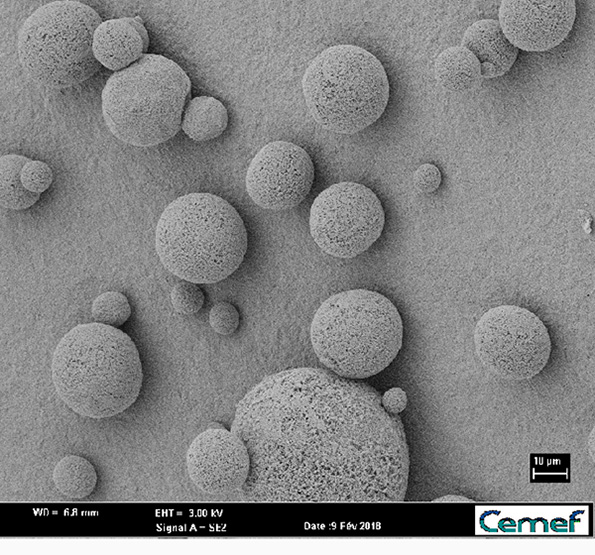Theme: Institution
Great future for biobased aerogels
24 April 2019

New exciting results on biobased aerogels (bio-aerogels) were obtained in the group of Tatiana Budtova. Fifteen years of research in this area resulted in breakthrough advancements.
To better understand the story, let us go back few years ago.
An European project Nanohybrids « New generation of nanoporous organic and hybrid aerogels for industrial applications: from the lab to pilot scale production » started at the end of 2015. CEMEF is involved in this project due to the previous results in the development of cellulose aerogels. The project is coordinated by Hamburg University of Technology. The objective is to make aerogels in the shape of beads of various sizes for different industrial applications. One of the requests is to make aerogels of very small size, below 30 microns.
Lucile Druel started her PhD thesis in the frame of this project, supervised by Tatiana. The scientific literature on this topic was practically non-existent. They tried to reproduce the published results but without success. However, they managed to develop a new approach and obtained aerogel beads of 20 microns in diameter.
This was the first success.
Tatiana explains: « Now our method is reliable and reproducible. It is a result of a fruitful collaboration with colleagues from Hamburg University of Technology. This is a great advantage of common research projects.”
Our story could stop here …. But research continues. In fact, to make aerogels a special drying, in supercritical conditions, is needed. This is to remove the solvent from the gel and preserve its porosity and nanostructure, which results in exceptional properties of aerogels: very low density, high adsorption capacity and insulation properties.
Drying in supercritical conditions is expensive. To make a bio-aerogel without such drying and preserve the nanostructure is a serious challenge.
« We were working following our intuition, but it is based on a long-lasting expertise in cellulose aerogels” said Tatiana.
They were advancing via trials and errors and finally found the way to preserve the properties of cellulose aerogels just drying at low vacuum (called xerogels), avoiding supercritical drying. This technique allows making cellulose aerogel-like monoliths and beads. It will greatly decrease the price of the material and thus open new prospects in the applications of new cellulose xerogels.
A patent was filed.
Tatiana Budtova is a leader of BIO group in CEMEF. She is working on bio-aerogels since 2004 and supervised five PhD theses on this topic.
Lucile Druel will defend her PhD thesis "Cellulose based aerogels: properties and shaping as beads" on May 10th, 2019.
Aerogels have their COST Action
24 June 2019

37 countries have confirmed their participation in the Horizon2020-funded COST Action AERoGels project.
COST? What is a COST? First of all, it is a programme dedicated to European Cooperation in Science and Technology which helps connecting research initiatives on selected topics across Europe and beyond. COST Actions are bottom-up networks that boost research, innovation and careers.
For COST Action AERoGELS, this is Tatiana Budtova, professor at CEMEF – MINES ParisTech and Francisco Ruiz from Keey Aerogel who have been appointed to represent France.
Tatiana is the head of BIO Team, « Bio-based Polymers and Composites » at CEMEF. CEMEF is world reknown leader in bio-aerogels, started working on this topic in early 21st century within the European project AeroCell. Since then, Tatiana and her team achieved great scientific progress in the field.
In the current Action, Tatiana has also been named head of the working group on environmental applications of aerogels.
In this Action, the use of aerogels will be focused on environmental and life sciences applications. Interest will be on treatment and removal of pollutants, energy management, life cycle analysis as well as pharmaceutical and bio-medical needs. The originality will be the combination of structure-properties correlations, regulatory aspects and circular economy approaches.
Aerogels are a special class of lightweight nanostructured materials with high and open porosity, very high internal pore surface area and tunable physicochemical properties. These properties make aerogels extremely versatile materials for numerous applications. Although some types of aerogels have already reached the market in construction materials and aerospace engineering, the full potential of aerogels is still to be discovered, tells us Tatiana. The interest of this Action is its interdisciplinarity between sectors with very little connexion. The long-term scope of this Action is to develop an aerogel technology able to improve the welfare of European people and to move towards cleaner and smarter production in Europe.
AERoGel COST Action started on April 30th, 2019 for a 4-year period with 37 European countries as well as Jordan, Russia and Costa Rica.
>> Visit AERoGELS COST Action website




